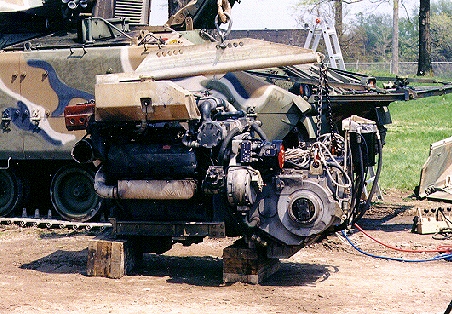
Introduced in 1988, the A2 received an improved 600 horsepower (447 kW) engine with an HMPT-500-3 Hydromechanical transmission.
Bradleys have a welded aluminum unit or monocoque structure to which the armor is attached, mostly on the outside. The suspension is by torsion bars and cranks. Six small rubber rimmed, divided road wheels on each side straddle the location flanges sticking up from the tread. These were originally of aluminum, but were changed to steel as vehicle weight increased. The steel treads sit on flat hard rubber tires. Mobility The Bradley is highly capable in cross-country open terrain, in accordance with one of the main design objectives of keeping pace with the M1 Abrams main battle tank. Whereas the M113 would float without much preparation, the Bradley was initially designed to float by deploying a flotation curtain around the vehicle. This caused some drownings due to failures during its first trials. Armor upgrades have negated this capability. The wide tracks and 600 horsepower turbo-diesel power plant give the vehicle the mobility it needs to keep up with the Abrams, and keep the soldiers it carries out of harms way. In order to fulfil the requirement for rapid worldwide deployability, the Bradley can be transported by truck, rail, ship and transporter aircraft. In addition, all Bradleys are amphibious. Early models were equipped with a water barrier, which is erected by the crew before entering the water � a procedure that takes about 30 minutes. Later models have an inflatable pontoon, which fits on the front and sides of the vehicle. This pontoon is inflated in about 15 minutes, and is continuously pressurized during operation. The pontoon is compartmentalized to provide protection against sinking in the event of rupture of the pontoon. Water propulsion is provided by tracks which propel the vehicle at about 4 MPH.
